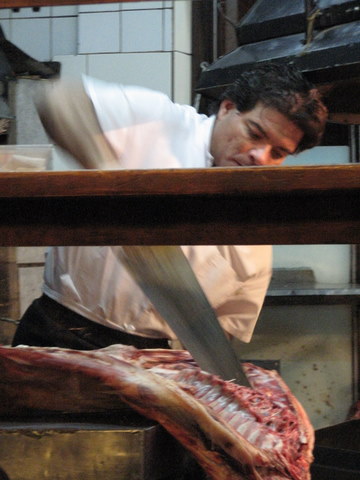There’s a great feel here; the people are lovely; the scenery is spectacular; everything seems less expensive than in Argentina, and the food — ah, dear friends, more on that soon.
Puerto Varas is a sweet, little, rose-filled town on the shore of Lake Llanquihue with a bit of a Santa Barbara feel – not much to do but a nice place to be despite the soon-to-be completed high-rise hotels. This is not a charming little fishing village, but it was a good place to catch our breath and get more information about the fire back home… and to eat our first chupes.
My chupe de centolla would give any cardiologist a heart attack just looking at it. It was a large gratin of fresh king crab with cream, Parmesan, a hint of sweet onion, topped with light, buttery crumbs. Think warm, cheesy crab dip but with 95% crab…the real stuff, not Krab…big hunks of crab…and heavy cream… and Italian Parmesan… and eaten with a fork or spoon instead of filling French bread…and all the double-dipping you could want. I found god in a crustacean casserole. What Alan’s chupe lacked in cream, it made up in other shellfish, chicken, and sausage. Price: about $4.50 per chupe.
In general, pescados y mariscos (fish and shellfish) are to Chile as beef is to Argentina. Good, cheap, plentiful and served in gigantic portions. One afternoon, we ate lunch at a semi-touristy place with pictures on the menu. I chose what looked like a small soup bowl of shellfish; Alan chose the salmon which we thought came with a side of ham and cheese. Alan’s dish arrived with two shoe-sized slabs of salmon with sausages, cheese and tomatoes sandwiched between them. Then came a small bowl of broth for dipping my shellfish and a plastic two-quart bowl for discarding the shells. We began to worry. With good reason.
Out came an enormous platter with no less than a dozen GIANT mussels, a couple dozen small mussels, and large handful of clams. Beneath all that was a substantial chunk of smoked meat, a chicken leg, an entire chorizo sausage, and two bagel-sized gordita sort of things stuffed with different meats and more sausage. Oh, and because we thought the photo on the menu probably exaggerated the volume of my entree and wouldn’t be enough, I ordered a little side salad of avo and hearts of palm—enough for four.
There was a huge influx of Swiss and Germans to this part of the country and that is strongly reflected in the kuchen (pastries) and architecture. Most of the houses are covered in ornate wooden shingles that would seem more likely in the Alps than in Patagonia, and the hostels and restaurants are filled with lots of shell mobiles, model ships, etc. Alpine Nautical Kitch is the dominant theme here. Unfortunately, the Chileans got the look of the pastry right, but not unlike the chocolate, the taste just isn’t there.
We bussed down to Isla Chiloe for a couple of days. We only saw a small area but loved it. Again, great feel, friendly people, gorgeous scenery and fabulous food. Oh, and did we mention los peros? There are lots of dogs everywhere – cute, gentle, well-fed, friendly pups. We love Chile.
One of Chiloe’s claims to fame is its wooden churches, designated as UNESCO World Heritage sites. We had read about them but didn’t understand the aesthetic appeal until we walked into Catedral San Francisco. Think basic Gothic cathedral but all wood, no stone, no plaster. Wood walls, wooden pillars, wooden arches. Think Norm Abrams on commission by the Medicis (or Phil Harris on crack with a newfound religious fervor).
Our last day on the island, we drove over rock and gravel roads through head high fields of psychedelic yellow mustard flowers to a broad, quiet beach that was deserted except for three guys wearing hip waders and a friendly woman who assisted them in digging a boat trailer out of the wet sand. The quartet then rolled up a chariot of sorts and we were wheeled into the water alongside the boat. From there, we motored around the nearby outcroppings to view sea otters, flocks of black cormorants and other birds, and what we had really made the trek to see — lots and lots of little penguinos – all doing those cute penguin things.
Next up: GOING HEAD TO HEAD – EASTER ISLAND
 guy with machete-sized knife and often a saw standing by to hack off a hunk of whatever you want). There’s a long buffet table full of all sorts of salads, many with heavy emphasis on the mayo; cold sliced meats; cheeses; fried calamari; marinated octopus; egg rolls (yes, egg rolls); and desserts. The place is packed with locals (a good sign) and a fair number of Argentine tourists.
guy with machete-sized knife and often a saw standing by to hack off a hunk of whatever you want). There’s a long buffet table full of all sorts of salads, many with heavy emphasis on the mayo; cold sliced meats; cheeses; fried calamari; marinated octopus; egg rolls (yes, egg rolls); and desserts. The place is packed with locals (a good sign) and a fair number of Argentine tourists.